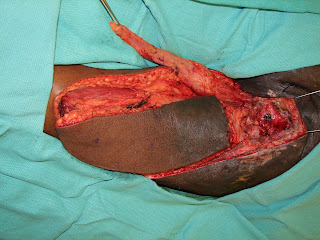Defects of the trunk and lower extremity can be challenging to close. Proper closure of these wounds can allow patients to return to their activities of daily living as well as to not have to take care of an open wound. Having an open wound on the body can be difficult for patients to take care of or their family members. Patients who are in wheelchairs are prone to pressure sores. In the wheelchair patient, these sores occur on the ischial tuberosity.
Appropriate closure of these defects requires that well vascularized tissue be brought into the defect for appropriate closure. In order for the tissue to heal, it is important that all non-viable tissue be removed and for a clean wound bed to be present. The patient must also have adequate nutritional stores. The first step in healing these wounds is proper debridement.
Once the wound is properly debrided, the next step is to cover the wound. In covering the wound, it is also important to make sure that all of the "dead space" that was created from the wound debridement is filled. The gracilis muscle is commonly used as a pedicled flap or as a free flap in microsurgery. According to Mathes and Nahai's classification, it presents a type II blood supply, based on the medial circumflex femoral artery. This artery enters the muscle about 10 cm from the pubic symphysis.
Below the gracillis muscle can be seen elevated which will be rotated and transferred into the debrided defect. Not only does the gracilis fill the "dead space" but it also provides a well vascularized tissue to deliver systemic antibiotics to any underlying osteomyelits or bone infection.
The V-Y Hanstring flap can then be elevated and advanced in the defect to close any remaining deadspace as well as to create a final wound closure.
Proper post-operative care of these wounds requires temporary immobilization to prevent shear trauma to the wound edges. Proper nutrition is also of paramount importance.
http://www.drbriandickinson.com/





